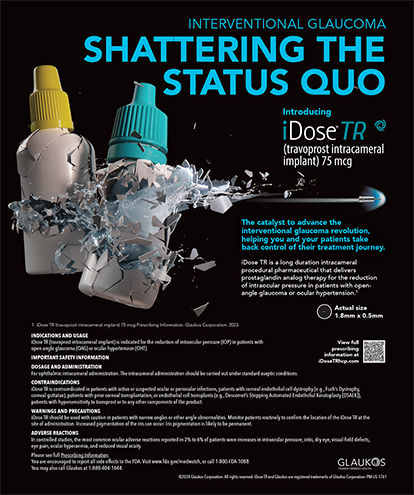A frustrating aspect surgeons will inevitably encounter is a mechanical malfunction. In both cataract and refractive surgery, we are dependent on the tools we use to improve our patients' visual acuity. When something goes wrong, we must be prepared mentally for a quick and accurate response to assure a successful outcome for our patients. I hope that my experience will serve as a lesson to better prepare other surgeons who may encounter a similar situation.
THE CASE
A 23-year-old white female patient presented for routine LASIK surgery. I chose to use a Hansatome™ microkeratome (Bausch & Lomb Surgical; Claremont, CA) to perform the procedure. Unfortunately, the microkeratome failed to reverse after completing the forward pass. After I made several attempts to advance and reverse, it was clear that the microkeratome would not reverse.
COURSE OF ACTION
I remained calm. I controlled the tone of my voice and calmly alerted my staff to the situation. I asked the technician to remove the suction, who, after doing so, stated that he had experienced this situation once before, and recommended that we dissemble the microkeratome and manually reverse the blade. He unscrewed the motor housing while I held the vacuum plate. Fortunately, the patient was compliant and able to hold still. After I removed the motor, I turned the axle of the pinion gear, bringing the blade back along the curved rack gear on the suction plate, which allowed me to extract the microkeratome.
Surgical Outcome
The patient's flap was folded and edematous, and there were some chatter marks distant from the visual axis. In addition, the inferior gutter was quite pronounced, but
symmetric. I placed a contact lens over the first eye; I decided to proceed with the other eye using a different microkeratome. Both eyes looked clear the next day. Following are the accounts of a few surgeons who have encountered a similar problem.
Gently Slide Off
If the Hansatome™ keratome does not reverse after the forward pass or stops at any point, you can stop suction and gently slide the keratome and suction ring as a single unit inferiorly towards the lower lid. Since the Hansatome™ produces a superior hinge, the flap should lay back in position as you move the keratome inferiorly off the cornea. Do not try to disengage the keratome from the suction ring or lift the unit too high off the eye until the flap is completely free as this may tear the flap. There is no reason to disassemble the keratome. Some surgeons after the forward pass, routinely perform this maneuver instead of the reverse pass in order to reduce suction time. Outcome is the corneal flaps look great.
Fort Lauderdale, Florida.
If this happens for any reason with any keratome, you can release the suction and slowly move the entire keratome/suction ring unit opposite the direction of the cut. It really just emulates what the keratome would do in reverse.
—J. Charles Casebeer, MD, President of CRS Clinical Research & Statistics of Divide, Montana.Check the Connection
I have found that the motor will not reverse if the gray cord that connects to the top of the keratome hand piece is too tight. I have had instances where the keratome moves forward to the end of its excursion, and then nothing happens when I press the reverse pedal. I have been able to “loosen” that gray cord attachment on the keratome hand piece (not completely detached, just loosened a bit), and attempt to press the reverse pedal, and it has worked. Also, if the keratome is truly jammed, you can break suction, ask the patient to look up slightly and slide the keratome off, without having to disassemble the entire keratome on the eye.
—Parag A. Majmudar, MD, Assistant Professor of Ophthalmology Cornea Service, Rush Medical College, Chicago Cornea Consultants, Ltd., Chicago, Illinois.


